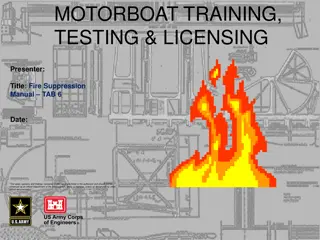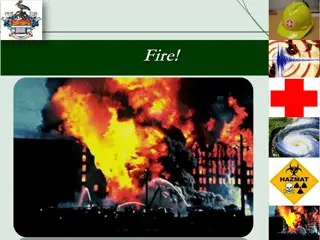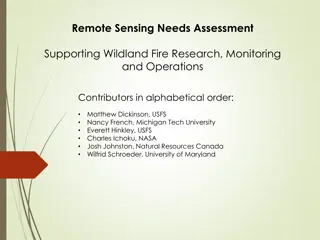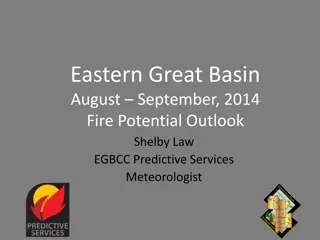Significant Fire Potential Outlook for Spring and Summer 2013
Northwest Geographic Area Coordination Center provides predictions for the fire season ahead, highlighting dry trends, temperature departures, and precipitation observations since January 2013. The outlook indicates unusually warm temperatures with continued dryness, particularly in the Pacific Northwest. Monitoring snowpack diminishing and potential wildfire risks in southern Oregon in May are also emphasized. Explore the climate summaries, snow percentages, and temperature and precipitation outlooks for May and beyond in this comprehensive report.
Download Presentation

Please find below an Image/Link to download the presentation.
The content on the website is provided AS IS for your information and personal use only. It may not be sold, licensed, or shared on other websites without obtaining consent from the author.If you encounter any issues during the download, it is possible that the publisher has removed the file from their server.
You are allowed to download the files provided on this website for personal or commercial use, subject to the condition that they are used lawfully. All files are the property of their respective owners.
The content on the website is provided AS IS for your information and personal use only. It may not be sold, licensed, or shared on other websites without obtaining consent from the author.
E N D
Presentation Transcript
Introduction to the Developmental Testbed Center's Model Evaluation Tools with an emphasis on object-based verification using the MODE tool John D McMillen
MET http://www.dtcenter.org/met/users/index.php http://www.dtcenter.org/met/users/support/online_tutorial/ METv4.1/index.php Locally: /uufs/chpc.utah.edu/sys/pkg/MET/v4.1/bin/
MET Gridpoint to gridpoint comparisons Gridpoint to fixed point comparisons Object-Based Analysis Ensemble Statistics Wavelet decomposition Several statistical analysis tools to produce information about several comparisons Filtering Aggregating Summaries Tools to format input data correctly for MET tools to work Bufr, GRIB, MADIS
Data Format Biggest challenge for me was getting my wrfout precip and radar estimated precip data into a file format that could be used by the MET tools I used the netcdf format of files from the tutorial to form netcdf files of each data set Headers and metadata all spoofed I regridded wrf data to the radar grid The radar grid was already regridded when saved via the NOAA toolkit
netcdf WRF20111203 { dimensions: netcdf NEXRAD20111203 { dimensions: lat = 372 ; lon = 446 ; lat = 372 ; lon = 446 ; variables: variables: double lat(lon, lat) ; double lon(lon, lat) ; double APCP(lon, lat) ; double lat(lon, lat) ; double lon(lon, lat) ; double APCP(lon, lat) ; APCP:name = "APCP" ; APCP:long_name = "Total precipitation" ; APCP:level = "A12" ; APCP:units = "mm" ; APCP:FillValue = -9999. ; APCP:init_time = "DTG matches tutorial to APCP:name = "APCP" ; APCP:long_name = "Total precipitation" ; APCP:level = "A12" ; APCP:units = "mm" ; APCP:FillValue = -9999. ; APCP:init_time = "DTG matches tutorial to spoof MET" UNIX EPOCH TIME spoof MET" ; ; APCP:init_time_ut = 1123372800 ; APCP:valid_time = "DTG matches tutorial to APCP:init_time_ut = 1123459200 ; APCP:valid_time = "DTG matches tutorial to spoof spoof MET" ; MET" ; APCP:valid_time_ut = 1123459200 ; APCP:accum_time = "Time matches tutorial to APCP:valid_time_ut = 1123459200 ; APCP:accum_time = "Time matches tutorial to spoof spoof MET" ; MET" ; APCP:accum_time_sec = 43200 ; APCP:accum_time_sec = 43200 ; // global attributes: // global attributes: :FileOrigins = "pcp_combine format spoofed :FileOrigins = "pcp_combine format spoofed with with MATLAB. precipnetcdf.m" ; MATLAB. precipnetcdf.m" ; :MET_version = "V4.1" ; :MET_tool = "NONE" ; :RunCommand = "Accumulation periods vary :MET_version = "V4.1" ; :MET_tool = "NONE" ; :RunCommand = "Accumulation periods vary by case" by case" ; ; :Projection = "LatLon" ; :lat_ll = 40.1044728531061 ; :lon_ll = -113.695467396193 ; :delta_lat = 0.00537799245557125 ; :delta_lon = 0.00537799245557125 ; :Nlat = 372. ; :Nlon = 446. ; :Projection = "LatLon" ; :lat_ll = 40.1044728531061 ; :lon_ll = -113.695467396193 ; :delta_lat = 0.00537799245557125 ; :delta_lon = 0.00537799245557125 ; :Nlat = 372. ; :Nlon = 446. ;
MET Config Files Tells the MET tool what to do
MET To Run Locally: .aliases file entry: setenv METBIN /uufs/chpc.utah.edu/sys/pkg/MET/v4.1/bin/ Command: $METBIN/grid_stat data/WRF20101027.nc data/NEXRAD20101027qcd.nc config/GridStatConfig -outdir out/grid_stat/2010_10_27 -v 4
Object-Based Verification The Method for Object-based Diagnostic Evaluation (MODE) developed by Davis et al. (2006a,b) is Used to: Identify Precipitation Objects Quantify Precipitation Object Attributes Compare Objects from REP and Simulated Precipitation MODE was Tuned to Identify GSLE Objects Specifically
Object-Based Verification WRF Object WRF R = 4 grid points, T = 1mm, Ignore Objects < 100 grid points
Object-Based Verification 90 Orientation Angle a Centroid Aspect Ratio = a/b b
Adjusting MODE Interest Function 0-1, 1 is a perfect match Defined by a function Weight How much influence a variable has in the Total Interest Integer Confidence 0-1, 1 is total confidence Usually 1 except for orientation angle and centroid separation























